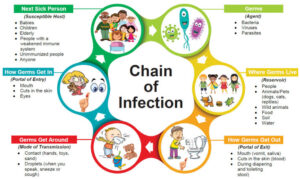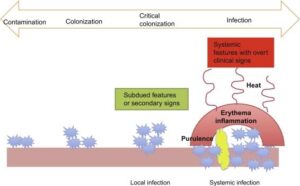Back to: MICROBIOLOGY 100 LEVEL
Welcome to class!
Hello there, superstar learner! It’s so wonderful to have you in class today. We’re about to look at a topic that explains how tiny organisms (called microbes) enter our bodies and cause illness. Think of it like how an uninvited guest might sneak into your house, settle in, and start giving you wahala (trouble). Today’s topic is Entry, Colonisation, and Infection—and I promise you’ll understand it like gist!
Entry, Colonization, And Infection
Entry into the Host
Microorganisms can only cause disease after entering your body. They do this through different portals of entry—that’s just a fancy way of saying entry points. Here are the most common:

Skin: through cuts, wounds, insect bites or injections.
Respiratory tract: when you breathe in droplets carrying viruses or bacteria—like during sneezing or coughing.
Digestive tract: by eating contaminated food or drinking unsafe water.
Genitourinary tract: through unprotected sex or poor hygiene.
Placenta: some microbes can pass from mother to baby during pregnancy.
Think of your body like a secured compound. Microbes are like intruders looking for an open gate, broken fence, or unlocked window to sneak in.
Colonisation
Once inside, the microbes don’t just move around aimlessly. They look for a place to settle down and multiply. This process is called colonisation.
Some may stay in the nose, mouth, intestines, or even on your skin—just like someone quietly renting a room in a house. At this stage, they don’t always cause harm. Some might even be part of your normal flora.
But if their numbers increase too much, or they release harmful substances, things can go wrong.
Infection
This is when the real trouble starts. Infection means the microbes have not only entered and colonised, but they are now damaging tissues and causing signs of illness like fever, pain, diarrhoea, or coughing.
So, infection is the result of:
Entry into the body
Colonisation and multiplication
Harm or damage to body tissues
Depending on how strong your immune system is, the infection may be mild or serious.

Imagine a thief (microbe) jumps your fence (entry), hides in your garage (colonisation), and then starts stealing your generator parts and disturbing your peace (infection). At first, you may not notice him (no symptoms), but once he causes damage, you call for help (immune response). That’s how your body reacts too!
Summary
- Microbes enter the body through skin, airways, food, or private parts.
- Colonisation is when they settle in and start to multiply.
- Infection occurs when they cause damage and signs of illness appear.
- A strong immune system helps stop infections early.
Evaluation
- What are the common portals of entry for microbes?
- What does colonisation mean?
- At what stage does a person start to show symptoms of disease?
- Give one example of a microbe entering through the respiratory tract.
- Why might colonisation not always lead to infection?
Every lesson brings you closer to being a knowledgeable and confident scientist or healthcare leader. Your mind is powerful, and Afrilearn is here to help you grow it every step of theway. Keep it up—you’re going far!
